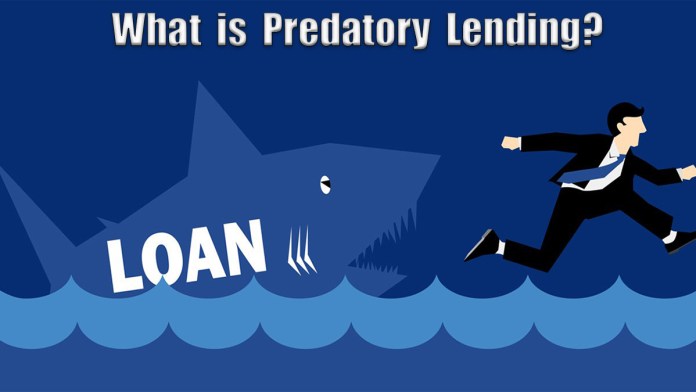When taking out a loan, it is important to watch out for signs of predatory lending. Predatory lending is simply when a lender takes undue advantage of a borrower through unfair, deceptive, and unmanageable loan terms. Predatory lending usually has an adverse effect on the borrower, as they are unable to repay their loan within the stipulated time.

If you plan on taking out a loan and you seek clarity and information on what to watch out for, you’re in the right place. In this article, we will shed more light on predatory lending, its examples, and tips on how to avoid it. In order not to miss out on key information, ensure you read to the end of this article.
What is Predatory Lending?
Predatory lending means imposing unfair and abusive loan terms on borrowers, which results in high fees and interest rates. Most often than not, predatory lenders tend to strip the borrower of equity and pressurize the lender into paying back the loan.
Predatory lending includes the use of aggressive sales tactics to exploit those who are not financially literate and lack an understanding of how loans work. In most cases, these predatory lenders often have a targeted, vulnerable population they exploit with their deceptive loan amount.
Examples of Predatory Lending
Undoubtedly, predatory lending is designed to benefit the lender, not the borrower. At first, it may seem like it favors the borrower, but in the long run, the reverse is the case. Thereby preventing the lender from repaying the loan amount. Highlighted below are a few examples and tactics to watch out for:
• No credit check
This is one of the most prominent examples of predatory lending. If your lender offers you a loan regardless of your credit score, that’s a red flag. Most renowned lenders assess the borrower’s credit score before giving out a loan to ensure timely payment and other factors. Not checking your credit score means they’re less concerned about your ability to pay back the loan amount.
• Short repayment terms
In the loan landscape, reputable lenders offer a considerable repayment term of about six months to several years. So, if you take out a loan that offers a very short timeline for repayment, avoid it. This shows they are less concerned with your financial capability.
• Excessive and abusive fees
This is also another example of predatory lending, which can be disguised as not being included in the interest rate of the loan you’re taking out. If the fees you’re to pay back are excessively high, don’t take out the loan.
• Balloon payment
This is one of the tactics used by predatory lenders. They make it seem like the substantial payment at the end of the month is low. However, it is not always the case. Most often than not, you may not be able to keep up with the balloon payment, which can result in refinancing and incurring new costs.
• Loan flipping
Loan flipping denotes when a lender pressurizes a borrower to refinance their loan by generating fees and points for the lender subsequently. This can trap the lender and put him/her in heavy loan debt. With this, lenders struggle to pay back their loans, and this may incur other penalties from the lender.
• Asset-based lending and equity stripping
Yet other tactics are used by predatory lenders. Here, the lender offers a loan based on your asset or any other valuable property. Whether or not you’re capable of paying it back is no business of theirs, as long as you have an asset that they can claim once you’re unable to pay it back. Why risk losing your home and other valuables when you can avoid it?
Unnecessary add-on products and services
When you notice there are unnecessary products or services added to your loan, such as single-premium life insurance for a mortgage, taking out that loan is not an ideal option.
How to Avoid Predatory Lending
We understand the challenge of detecting predatory lending. Not too many people can easily spot one. That is why we have helped to curate some tips on how to avoid and protect yourself from predatory lenders. They are as follows:
- Educate yourself and be financially literate. This would help you to easily spot red flags and avoid predatory lenders. If the offers seem too good to be true, that’s one red flag right there.
- Ensure you compare mortgage fees and rates in order to have a better understanding of how the loan works.
- Seek guidance from a certified housing counselor; they can easily identify predatory lending if they see one.
- Know the signs and patterns in which predatory lending showcases itself. This would ultimately help you avoid them, even without being told.
FAQs
Can predatory lending be considered a crime?
Of course, it is a crime. If you’re being misled or compelled into taking out a loan that attracts a ridiculous fee not compatible with your risk profile, then it is no longer an offer of help; it is a criminal act.
So many of these predatory lenders get away with their crimes because consumers are oblivious to their rights. The good news is that there are laws that protect individuals when there’s an occurrence of predatory lending.
Is it possible to sue for predatory lending?
Yes, if you are able to prove that your lender violated the laws, including the Truth in Lending Act, then you can file a lawsuit. Remember, it is easier when you have proof of the rules broken by this lender, which increases your chances of being compensated.
The first thing to do is consult your state consumer protection agency and state the exact problem in detail. They will now know the next course of action to take.



